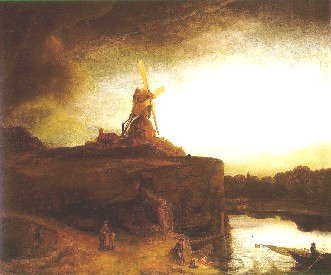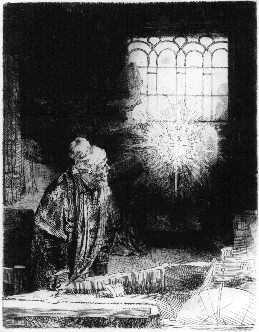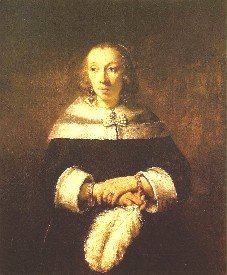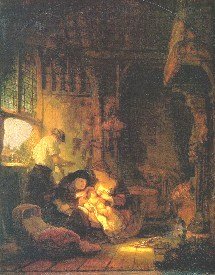
Not only was Rembrandt van Rijn one of the greatest Dutch painters, he was also, although not as well-known, a great etcher and drawer. In his live time he would changed the way many artist painted. For example, while many other Dutch painters emphasized things such as realistic appearances of their models, he tried to portray them more in a poetic manner than realistically. By using extreme light-to-dark values he created interesting effects not used by many other painters.
In Rembrandt's earlier years as an artist he first stressed action, drama, and high contrast between dark and light. Rembrandt had no restrictions with his space, he was not afraid to let the colors seam to seep out of the frame, not holding anything in place.
Later his art became mellow and almost glowing with bright colors. Subtly, he reflected thoughts and feelings in each of his portraits of scenes. In many of Rembrandt's paintings our eye does not see the details of the whole painting, but instead allows us to pick out the essential parts for understanding the scene. Thus by light and dark he turns a complicated scene and story into a powerful visual story for the eyes. Rembrandt shows us that a line can give the impression of depth and also how heavy or light the stroke of the brush is.

Rembrandt excelled in etchings and prints like other Dutch artists such as Durer. In contrast with Durer he left scenes to the imagination rather than spelling them out for us. He was a maker of moods, merely suggesting with his prints and etchings the meaning and mood not the whole story.

Born as Rembrandt Harmen Szoon van Rijn in Leiden in 1606, he was the son of a miller. He briefly attended the university of Lieden and then turned to art studying under Pieter Lastman in Amsterdam, Where he later decided to live. In 1634 he married Saskia van Uijlenburgh and became a portrait painter, a lucrative business. Unfortunately three out of his four children died at young ages, and Saskia also died in 1642 leaving him feeling very lonely and isolated.

It was the height of fashion for the wealthy people of Amsterdam to have their portraits painted by Rembrandt for about a decade. He was more interested in religious scenes though for private collectors rather than for churches.

Rembrandt became increasingly unsociable and began to manage his finances badly. By 1656, he could no longer pay his debts. But with the help of his son Titus, and his housekeeper Hendrickje Stoffels (later his wife) he managed to set up a small shop. Soon after his son and wife both died leaving him to live alone and poverty stricken.
By the time Rembrandt died in 1669, a lonely and poor man he was almost forgotten. Yet today his artwork contains verisimilitude for artists of all ages.
Sources:
Lowry, Bates. The Visual Experience. Englewood Cliffs: Prentice Hall, unknown.
Janson, H.W., and Dora Jane Janson. The Story of Painting. New York: Harry N. Abrams Inc., 1952.
Picture Credits:
Picture #1 - "Self Portrait" from: http://www.artchive.com/artchive/ftptoc/rembrandt_ext.html
Picture #2 - "The Mill" from: http://www.artchive.com/artchive/ftptoc/rembrandt_ext.html
Picture #3 - "Faust" from: http://titus.ispec.net/faust.html
Picture #4 - "Portrait of a Lady with an Ostrich Feather Fan" from: http://www.artchive.com/artchive/ftptoc/rembrandt_ext.html
Picture #5 - "Holy Family" from: http://www.artchive.com/artchive/ftptoc/rembrandt_ext.html